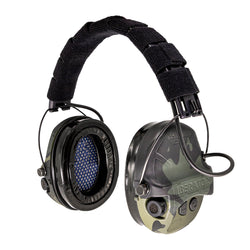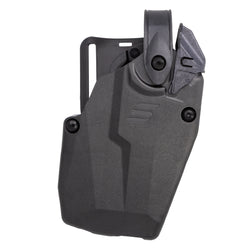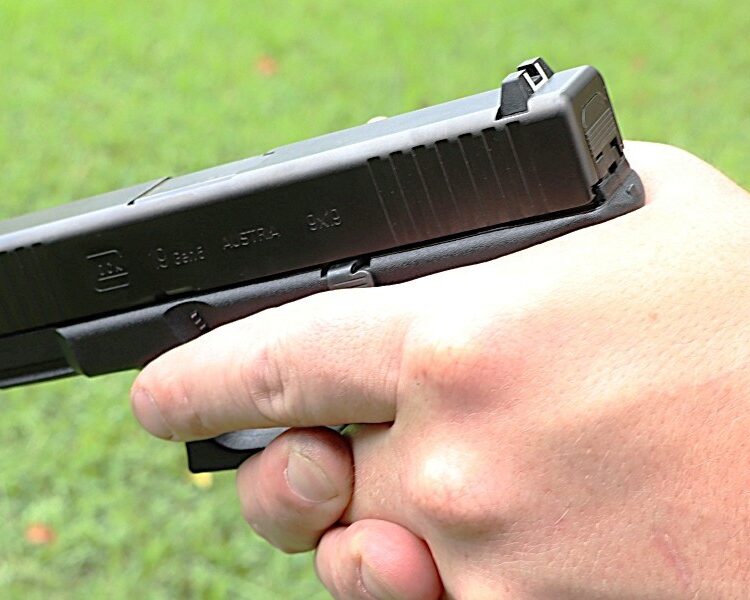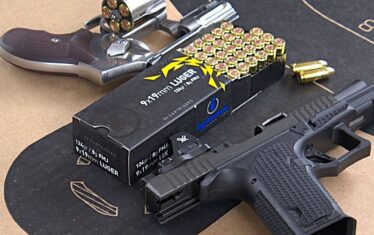Although polymer-framed pistols feel like a recent innovation, the Glock 19 has held sway on that market for close to 40 years. Even with so much competition in the market today, it is hard not to see the Glock 19 as a default 9mm handgun.
From its introduction in 1988 until today, there have been precious few changes. It is a testament to the design and the loyal following it commands. But some of those changes can make the difference.
Evolution of the Glock 19: Why the Gen 5 Matters
The latest iteration, the Glock 19 Gen 5, among other features, gives us a truly ambidextrous option. As a resident southpaw of CADRE Dispatch, here is my critical take on the updated legend.
The bug and feature of Glock as a brand is how little the design has changed over time. The Glock 19 was perfectly functional in 1988 and never needed excessive refinement. With that said, the conservative modifications Glock has done over the years tangibly affect the shooting experience.
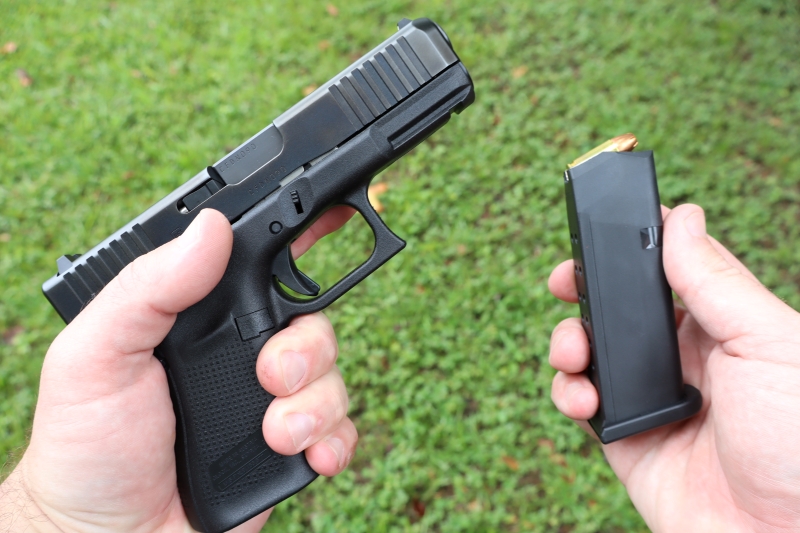
Ambidextrous Controls and Optics Compatibility
The Gen. 5 Glock 19 features the same polymer frame, tenifer-treated stainless steel slide, Safe-Action firing mechanism, 15-round capacity, and utilitarian look as any other. Marginal improvements include the use of forward and rearward cocking serrations not seen on previous generations.
The greater game changer is ambidextrous control and the potential for optics compatibility from the factory.
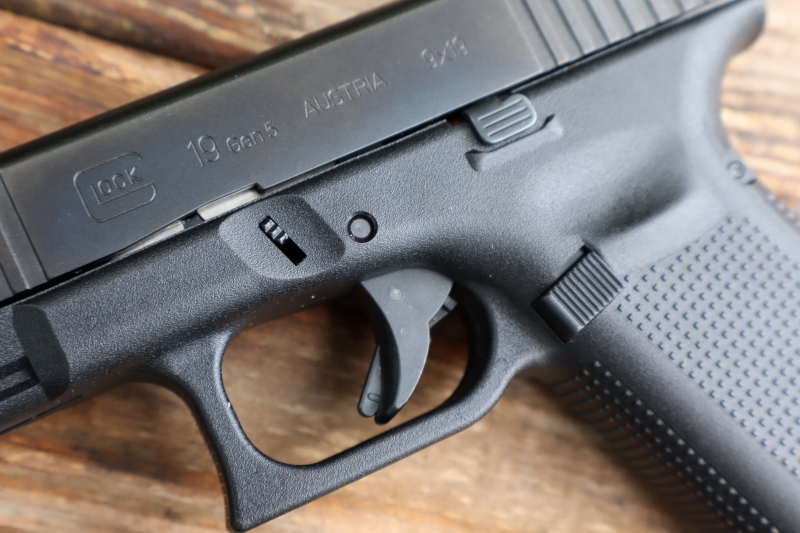
All Glock 19 Gen. 5 pistols come with an ambidextrous slide release and a reversible magazine release button that can be readily set up for a left-handed shooter. That is the big game changer for about 10% of first responders, armed citizens, and shootists.
The Gen 5 features the same front white dot and rear notch sights as earlier models, while the G19 MOS variant comes optics-ready. I opted for the standard G19 Gen. 5 sans optic. Other features carried over include a universal light rail, squared-off trigger guard, and flared magazine well. The pistol ships with a set of interchangeable backstraps and three magazines in the infinitely familiar Glock hard-sided case.
Glock 19 Gen 5 Specs at a Glance
- Caliber: 9mm Luger
- Capacity: 15+1
- Barrel Length: 4 inches
- Overall Length: 7.4 inches
- Width: 1.25 inches
- Weight: 1 lb. 6.5 oz. (unloaded)
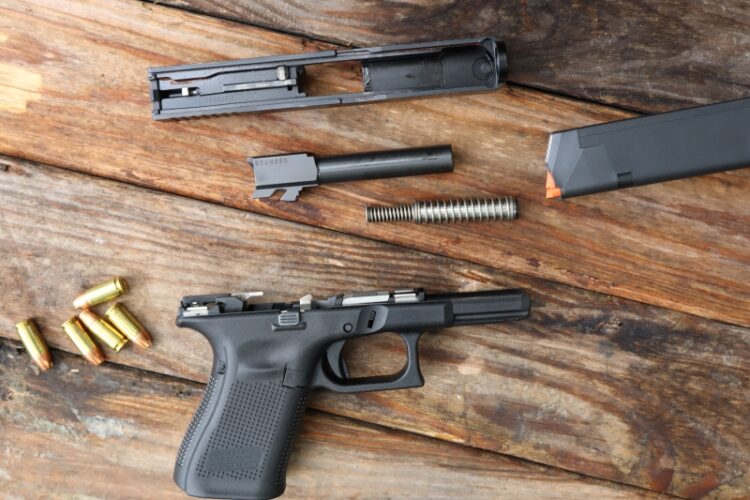
What Makes This Review Different?
The Glock 19 has been reviewed extensively, although the Gen. 5 model has been reviewed less so. But many reviews I have seen come from a place of great experience. As such, the reviewer can assume the audience is in the know. It is also tempting for a reviewer to not compare it to other experiences and tune out demerits and focus on merits that might be overblown.
I sought out the Glock 19 Gen. 5 to not only get a left-handed shooter’s perspective, but to give it a completely fresh look. I like hammer-fired pistols and have some trigger time with a handful of Glock clones, but very little with Glock pistols and no experience with the Glock 19 at all.
First Impressions and Ergonomics
Handling and Balance
When you first pick up a Glock G19, you notice how light and off-balance it feels. That goes away as soon as it is loaded. With 15 rounds in the pistol, you feel the tangible heft of a service handgun. It is somewhat rear-heavy, which makes the front sight stand ever so slightly proud when indexed.
The Glock’s grip angle requires a slight downward point to bring sights on target, much like a double-action revolver. This makes sense, given Glock’s role in replacing revolvers in law enforcement. It requires deliberate use of the sights. Some detractors blame the Glock’s grip angle for the awkward hold, but it is no different than the original and pointable GI 1911.
Grip Angle and Trigger Reach
Whether you like the Glock grip angle or not, it is hard to argue that it is hand-filling. The Gen. 5 model features a slightly easier trigger reach and adaptable ambidextrous controls. Unlike other pistols, where the left-handed controls are too small or too difficult to use, the Glock 19 Gen 5 pulls no punches.

Accuracy Testing & Ammunition Performance
I began a 300-round evaluation of the Glock 19 Gen. 5 with simple off-hand accuracy testing to see where the iron sights were hitting and see if the G19 has a favorite ammunition. While most quality ammunition will shoot well enough for the intended purpose, some pistols simply agree with certain types of ammunition, both in the accuracy and reliability department.
I fired a series of 10-round groups at ten yards with the following loads:
- Magtech 115 grain FMJ
- Magtech 124 grain FMJ steel cased
- Winchester 115 grain JHP
- Hornady Critical Defense 135 grain +P FTX
- Federal HST 147 grain subsonics
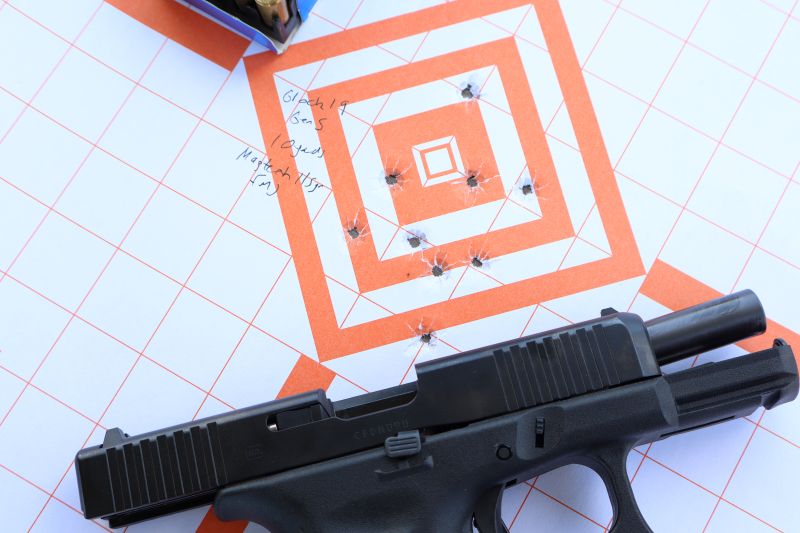
At 10 yards, I could reliably put 10 rounds into a 3-inch group with the standard pressure 115-grain loads turning in the very best performance. The sights are crisp enough to do target work, and the front sight jumps into view without covering up the intended aiming point. That is good to know if you are only given a small target to work with in the first place.
Trigger Feel
The only limitation is the mechanical sponginess of the trigger. It is neither light nor heavy, breaking at just over 5.5 lbs. on my Lyman trigger scale.
While no one can say a Glock has a great trigger with a straight face, it is a good short trigger with enough mush for safety when coming in and out of the holster, as well as enough play to allow the shooter a chance to back off, if need be.
Comparing the Glock 19 Gen 5 to Other Pistols
Recoil Management and Controls
Ergonomics is part subjective and part objective. Some guns you can tell intuitively will shoot well because of accuracy-enhancing features and fit, and you can access the controls with minimal trouble. In the case of Glock handguns, and the 19 in particular, it is a case of two handguns: the one you pick up off the shelf and the one hot from use on the range.
The way the slide release and magazine release interface did not change. Nor did the inherent balance point. The flared magazine well did marginally help with reloading without looking at the pistol, at least it did over my Gen. 3 clone that does not have that feature. The standout part is, as light as the G19 is, it has no business being as easy to shoot as it is.
Conventional wisdom would dictate that heavier all-metal handguns are easier to shoot because their weight soaks up felt recoil and prevents muzzle rise. The smaller and lighter the gun, the tougher recoil management becomes.
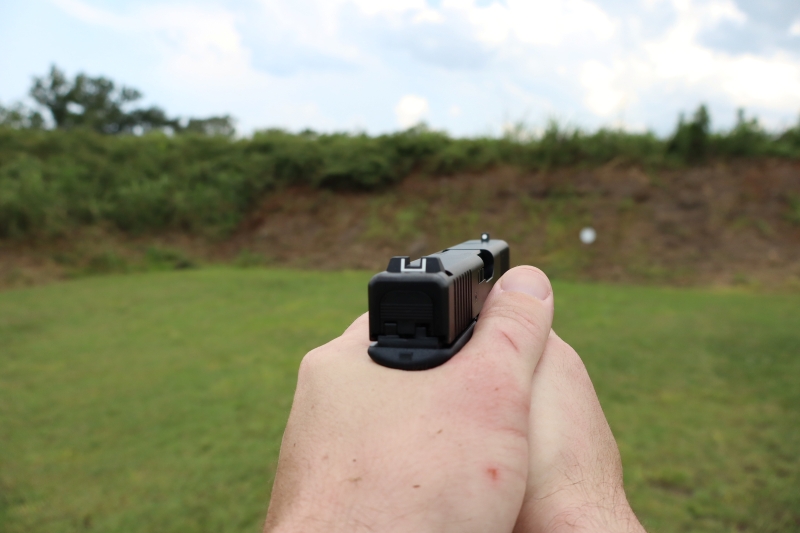
The G19 is infinitely easier to work with than any microcompact or single-stack handgun. That comes as no surprise, as it is more on the full-size footprint. Compared to the Glock 48 I shot alongside it, the G19 had about half the felt recoil and faster recovery between shots. The wider grip and beefier slide distribute the recoil better. What was more surprising is how the G19 fared against other full-sized handguns in the metal category.
Comparison with Glock 48 and CZ Models
I shot the G19 Gen. 5 in rotation with the G48, but also a pair of all-metal CZs—a CZ P01 and my personal CZ 75B. The P01 is closer in size to the G19, and the 75B is a full-sized all-steel service pistol. I did favor the triggers on the latter, but from an objective standpoint, neither pistol had a perceived advantage over the G19 in terms of recoil.
It even outdid my Rainier Dusk 19R Glock clone, even though it is a ported handgun. The use of a dual recoil spring on the Gen 5, compared to the single spring of Gen 3 handguns, is a significant improvement. Quite a surprise on all accounts!
Reliability
Reliability will be short, sweet, and to the point. Out of 300 rounds fired using both standard Glock magazines as well as aftermarket KCI Glock mags, I had no malfunctions and no failures to fire. For all the criticism leveled against Glock pistols, they tend to go bang when you pull the trigger as long as you give it a modicum of maintenance.
Glock 19 Gen. 5: A Deserving Staple
The Glock 19 Gen. 5 is one of the safest bets you can make when it comes to buying a handgun today. It does not wow with flashy features like interchangeable aluminum mag wells, sea-shell stippling, and radioactive sights, but it taps into Glock’s legendary reliability and unmatched aftermarket support. It improves on Gen 3 and Gen 4 models and is a good all-around pistol to own both because of, and in spite of, the changing face of the market and shooters’ needs.


